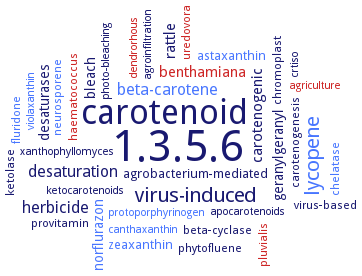Please wait a moment until all data is loaded. This message will disappear when all data is loaded.
Please wait a moment until the data is sorted. This message will disappear when the data is sorted.
evolution
-
approximately 10% of known phytoene desaturases, as in Rhodobacter, produce neurosporene, whereas the rest produce lycopene. These two types of enzymes, although similar in function, have relatively low similarity, below 60%, in terms of nucleotide or amino acid sequence. Phytoene desaturase encoded by gene crtI is a neurosporene-producing enzyme
metabolism

-
the expression of zeta-carotene desaturase paralleles plastid terminal oxidase (PTOX, quinol:oxygen oxidoreductase) and zeta-carotene desaturase. The three genes are expressed when carotinoid biosynthesis is enhanced during fruit ripening
metabolism
-
the expression of zeta-carotene desaturase paralleles plastid terminal oxidase (PTOX, quinol:oxygen oxidoreductase) and zeta-carotene desaturase. The three genes are expressed when carotinoid biosynthesis is enhanced during fruit ripening. Tomato ghost mutant with impaired plastid terminal oxidase accumulate phytoene in leaves and fruits
metabolism
carotene desaturation, an essential step in the carotenoid biosynthesis pathway, is catalyzed by two carotene desaturases, phytoene desaturase, PDS, and zeta-carotene desaturase, ZDS
metabolism
-
the zeta-carotene desaturase is involved in the carotenogenic pathway, overview
metabolism
the zeta-carotene desaturase is involved in the carotenogenic pathway, that is made up of three main parts: geranylgeranyl diphosphate biosynthesis, lycopene generation, and the formation of carotenoids with cyclohexene and their derivatives, overview
metabolism
-
phytoene desaturase CrtI from Rubrivivax gelatinosus catalyzes simultaneously a three- and four-step desaturation producing both neurosporene and lycopene. These carotenes are intermediates for the synthesis of spheroidene and spirilloxanthin, respectively
metabolism
-
the enzyme is important in carotenoid biosynthesis pathway in citrus fruits, overview
metabolism
-
ZDS is a key enzyme in carotenogenesis serving downstream of zeta-carotene in the carotenoid biosynthetic pathway, overview
metabolism
-
the zeta-carotene desaturase is involved in the carotenogenic pathway, overview
-
metabolism
-
phytoene desaturase CrtI from Rubrivivax gelatinosus catalyzes simultaneously a three- and four-step desaturation producing both neurosporene and lycopene. These carotenes are intermediates for the synthesis of spheroidene and spirilloxanthin, respectively
-
metabolism
-
the enzyme is important in carotenoid biosynthesis pathway in citrus fruits, overview
-
metabolism
-
the zeta-carotene desaturase is involved in the carotenogenic pathway, that is made up of three main parts: geranylgeranyl diphosphate biosynthesis, lycopene generation, and the formation of carotenoids with cyclohexene and their derivatives, overview
-
metabolism
-
ZDS is a key enzyme in carotenogenesis serving downstream of zeta-carotene in the carotenoid biosynthetic pathway, overview
-
physiological function

-
phytoene desaturase encoded by crtI catalyzes the desaturation of phytoene in the carotenoid biosynthesis pathway, approximately 10% of known phytoene desaturases, as in Rhodobacter, produce neurosporene, whereas the rest produce lycopene, mechanism controlling the product specificity, phytoene desaturase encoded by gene crtI is a neurosporene-producing enzyme, overview
physiological function
-
Zds is a key gene important in the regulation of carotenoid accumulation, including the early steps of the pathway, regulated during fruit maturation. Altered flow of carotenoid precursors during fruit maturation due to abscission agents is suggested by changes in phytoene desaturase and zeta-carotene desaturase gene expression. As fruit mature, increased phytoene desaturase (Pds) and zeta-carotene desaturase (Zds) gene expression result in increased downstream carotenoid content
physiological function
three functional units, comprising genes PSY1, PDS/ZISO, and ZDS/CrtISO, are responsible for the synthesis of 15-cis-phytoene, 9,9'-di-cis-zeta-carotene, and all-trans-lycopene, respectively. All-trans-z-carotene is detectable in nonsilenced fruits and greatly increases in ZDS-silenced ones
physiological function
-
Zds is a key gene important in the regulation of carotenoid accumulation, including the early steps of the pathway, regulated during fruit maturation. Altered flow of carotenoid precursors during fruit maturation due to abscission agents is suggested by changes in phytoene desaturase and zeta-carotene desaturase gene expression. As fruit mature, increased phytoene desaturase (Pds) and zeta-carotene desaturase (Zds) gene expression result in increased downstream carotenoid content
-
additional information

-
the differential accumulation of carotenoids in red- and yellow-fleshed papaya varieties, being higher in the red-fleshed variant, might be partly explained by the transcriptional level of CpPDS, encoding phytoene desaturase, and CpZDS
additional information
-
Leu208, located in a highly hydrophobic membrane-integrated region, is important in substrate binding
additional information
-
the differential accumulation of carotenoids in red- and yellow-fleshed papaya varieties, being higher in the red-fleshed variant, might be partly explained by the transcriptional level of CpPDS, encoding phytoene desaturase, and CpZDS
-
additional information
-
Leu208, located in a highly hydrophobic membrane-integrated region, is important in substrate binding
-




 results (
results ( results (
results ( top
top






